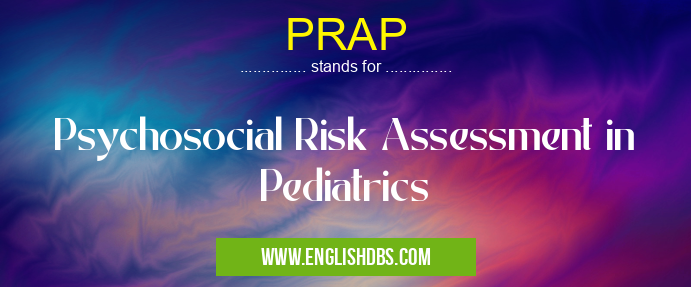What does PRAP mean in PEDIATRIC
Psychosocial Risk Assessment in Pediatrics (PRAP) is a tool used by healthcare professionals to identify children who may be experiencing psychosocial stressors that could negatively impact their health and well-being. PRAP aims to assess the child's environment, family dynamics, and any external factors that may contribute to psychosocial risks.

PRAP meaning in Pediatric in Medical
PRAP mostly used in an acronym Pediatric in Category Medical that means Psychosocial Risk Assessment in Pediatrics
Shorthand: PRAP,
Full Form: Psychosocial Risk Assessment in Pediatrics
For more information of "Psychosocial Risk Assessment in Pediatrics", see the section below.
What does PRAP stand for?
P Psychosocial R Risk A Assessment P Pediatrics
Purpose of PRAP
The primary purpose of PRAP is to:
- Identify children at risk for psychosocial problems.
- Guide healthcare professionals in developing appropriate interventions to mitigate these risks.
- Monitor children over time to track progress and adjust interventions as needed.
Importance of PRAP
Early identification and intervention of psychosocial risks in children are crucial for several reasons:
- Improved Health Outcomes: Addressing psychosocial stressors can reduce the risk of developing mental health issues, substance abuse, and chronic health conditions.
- Enhanced Child Development: PRAP helps ensure that children receive the necessary support to reach their developmental milestones and thrive academically, socially, and emotionally.
- Prevention of Adverse Experiences: PRAP can help healthcare professionals identify and intervene in situations that could lead to child abuse, neglect, or other traumatic experiences.
Components of PRAP
A comprehensive PRAP typically includes an assessment of:
- Child's Characteristics: Developmental history, behavioral patterns, social skills
- Family Environment: Family structure, parenting practices, support systems
- Social Context: School performance, peer relationships, neighborhood factors
- External Factors: Exposure to violence, poverty, or other significant stressors
Essential Questions and Answers on Psychosocial Risk Assessment in Pediatrics in "MEDICAL»PEDIATRIC"
What is the Psychosocial Risk Assessment in Pediatrics (PRAP)?
PRAP is a screening tool used by healthcare professionals to identify children and adolescents who are at risk for developing psychosocial problems. It evaluates factors such as family dynamics, peer relationships, school performance, and behavioral issues.
Why is PRAP important?
Early identification of psychosocial risks allows for timely intervention and support, which can help prevent the development of more serious problems, such as mental health disorders, substance abuse, and juvenile delinquency.
Who should undergo PRAP?
PRAP is recommended for all children and adolescents, particularly those who are experiencing changes or stressors in their lives, such as divorce, family conflict, or academic difficulties.
How is PRAP conducted?
PRAP involves a brief interview with the child or adolescent and their parent or caregiver. The interviewer asks questions about the child's family, school, peers, and behavior.
What happens after PRAP is completed?
After PRAP, the healthcare professional will assess the child's risk level and discuss the results with the parent or caregiver. If risks are identified, the professional may recommend interventions, such as therapy, support groups, or educational resources.
Is PRAP confidential?
Yes, PRAP is confidential. The information gathered is used solely for the purpose of assessing risk and providing support.
Can PRAP be repeated?
Yes, PRAP can be repeated over time to monitor changes in a child's psychosocial risk factors and adjust interventions accordingly.
Final Words: PRAP is an essential tool for healthcare professionals working with children. By identifying and addressing psychosocial risks early on, PRAP can improve health outcomes, promote child development, and prevent adverse experiences. It is a valuable asset in ensuring the overall well-being of children and their families.
PRAP also stands for: |
|
| All stands for PRAP |
